HOWARD CARTER-THE TOMB OF TUTANKHAMEN-VOLS 1 & 2 (SIGNED)-1STs-HB-A-ULTRA RARE
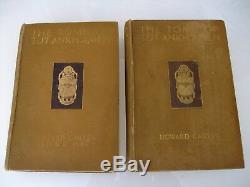
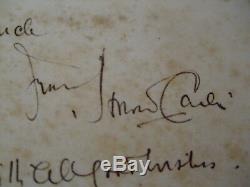
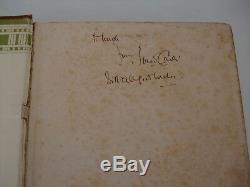
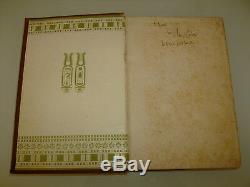
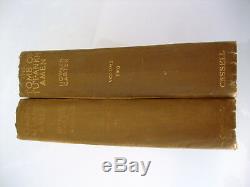
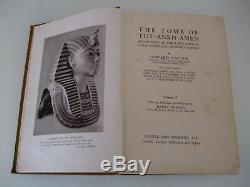
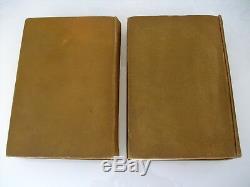
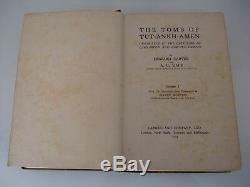
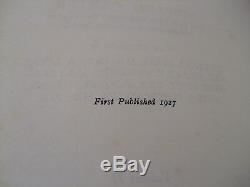
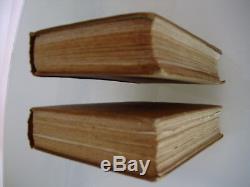
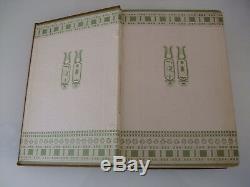
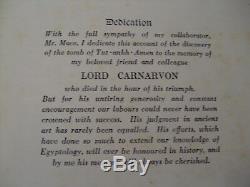

Two Acceptable/Good (volumes I and II), ULTRA-ULTRA-RARE, signed and dedicated by Howard Carter to f. Of volume II - see pictures, first Impression, first edition hardback books of'The Tomb Of Tutankamen'. Original brown cloth, titles gilt to spines and enclosing gilt scarab device on black ground to front covers, pictorial endpapers (one front endpaper from volume II missing, making the signed page the first page of the book - see pictures). Was substantially written by Carter's principal assistant, Arthur C. Volume I is missing the frontis photograph of Lord Canarvon (see picture). Books show fairly heavy wear all around. Bindings appear delicate, but are holding well. Published by Cassell, 1923 and 1927.
The tomb was discovered by the Earl of Carnarvon and Howard Carter. In the summer of 1922 Carter persuaded Carnarvon to allow him to conduct one more campaign in the valley. Starting work earlier than usual Howard Carter opened up the stairway to the tomb of Tutankhamen on 4 November 1922.
Carnarvon hurried to Luxor and the tomb was entered on 26 November. The discovery astounded the world: a royal tomb, mostly undisturbed, full of spectacular objects. Carter recruited a team of expert assistants to help him in the clearance of the tomb, and the conservation and recording of its remarkable contents. On 16 February 1923 the blocking to the burial chamber was removed, to reveal the unplundered body and funerary equipment of the dead king. Unhappily, the death of Lord Carnarvon on 5 April seriously affected the subsequent progress of Carter's work. In spite of considerable and repeated bureaucratic interference, not easily managed by the short-tempered excavator, work on the clearance of the tomb proceeded slowly, but was not completed until 1932.Carter handled the technical processes of clearance, conservation, and recording with exemplary skill and care. (9 May 1874 2 March 1939) was a. Who became world-famous after discovering the intact tomb designated. Of the 18th Dynasty Pharaoh. (colloquially known as "King Tut" and "the boy king") in November 1922.
Employed Howard Carter to supervise Carnarvon's Egyptian excavations in the Valley of the Kings. Introduced the two to ensure that Howard Carter imposed modern archaeological methods and systems of recording. Carnarvon financed Carter's work in the Valley of the Kings to 1914, but excavations and study were interrupted until 1917 by the First World War. Carter enthusiastically resumed his work following the end of the First World War. After several years of finding little, Lord Carnarvon became dissatisfied with the lack of results, and informed Carter in 1922 that he had one more season of funding to search the Valley of the Kings and find the tomb.
On 4 November 1922, Carter's excavation group found steps that Carter hoped led to Tutankhamun. S tomb subsequently designated KV62. , and he wired Lord Carnarvon to come to Egypt. On 26 November 1922, Carter made a "tiny breach in the top left hand corner" of the doorway, with Carnarvon, his daughter Lady Evelyn Herbert, and others in attendanceand using a chisel that his grandmother had given him for his 17th birthday. He was able to peer in by the light of a candle and see that many of the gold and ebony treasures were still in place.
He did not yet know whether it was "a tomb or merely a cache", but he did see a promising sealed doorway between two sentinel statues. Carnarvon asked, Can you see anything? " Carter replied with the famous words: "Yes, wonderful things! The next several months were spent cataloguing the contents of the antechamber under the "often stressful" supervision of Pierre Lacau. Director general of the Department of Antiquities of Egypt. On 16 February 1923, Carter opened the sealed doorway and found that it did indeed lead to a burial chamber, and he got his first glimpse of the sarcophagus. All of these discoveries were eagerly covered by the world's press, but most of their representatives were kept in their hotels; only H.Was allowed on the scene, and his vivid descriptions helped to cement Carter's reputation with the British public. Carter's own notes and photographic evidence indicate that he, Lord Carnarvon, and Lady Evelyn Herbert entered the burial chamber shortly after the tomb's discovery and before the official opening. The tomb is considered the best preserved and most intact pharaonic tomb ever found in the Valley of the Kings. The clearance of the tomb with its thousands of objects continued until 1932.
Following his sensational discovery, Carter retired from archaeology and became a part-time agent for collectors and museums, including the Cleveland Museum of Art. And the Detroit Institute of Arts.
He visited the United States in 1924 and gave a series of illustrated lectures in New York City and other cities in the US that were attended by very large and enthusiastic audiences, sparking American Egyptomania. Carter died of lymphoma in Kensington. London, on 2 March 1939, aged 64. Carter is now buried in Putney Vale Cemetery. His epitaph reads: "May your spirit live, may you spend millions of years, you who love Thebes, sitting with your face to the north wind, your eyes beholding happiness", a quotation taken from the Wishing Cup of Tutankhamun.
And "O night, spread thy wings over me as the imperishable stars". The item "HOWARD CARTER-THE TOMB OF TUTANKHAMEN-VOLS 1 & 2 (SIGNED)-1STs-HB-A-ULTRA RARE" is in sale since Tuesday, April 16, 2019. This item is in the category "Books, Comics & Magazines\Non-Fiction". The seller is "chancebooks2011" and is located in bolton, Lancashire.
This item can be shipped worldwide.- Special Attributes: 1st Edition

